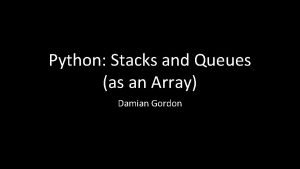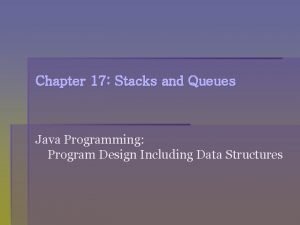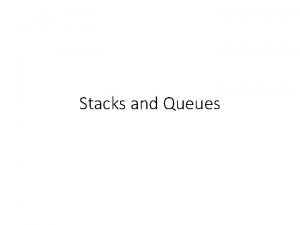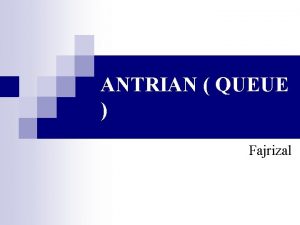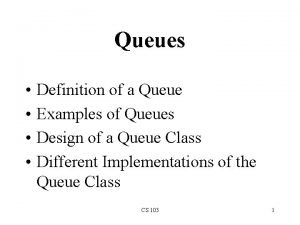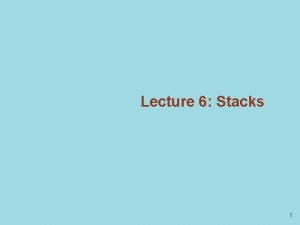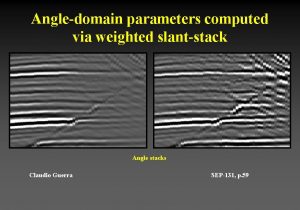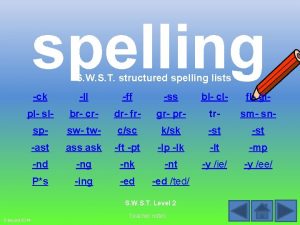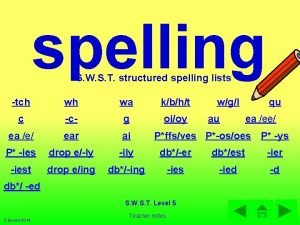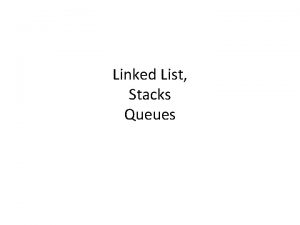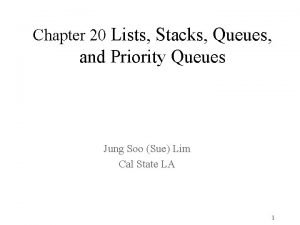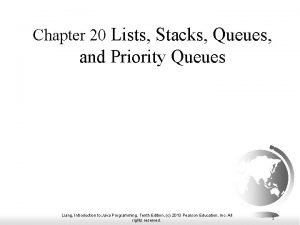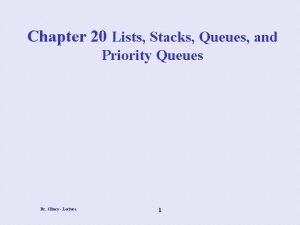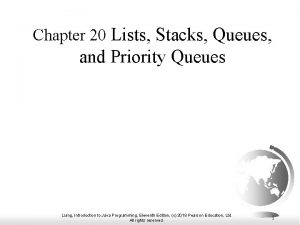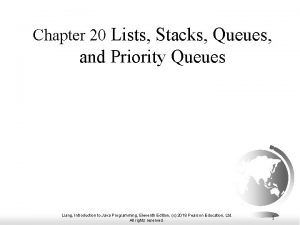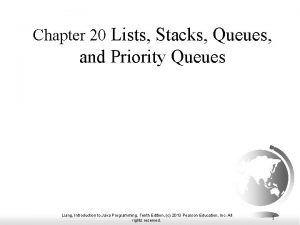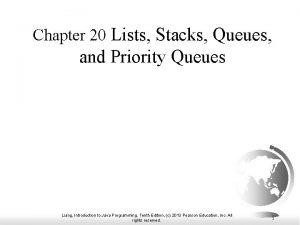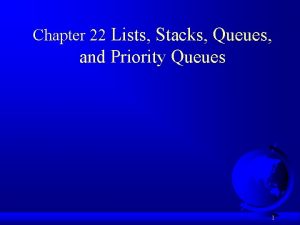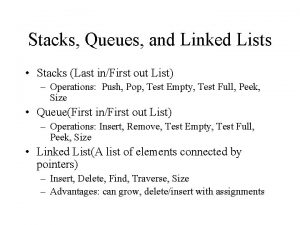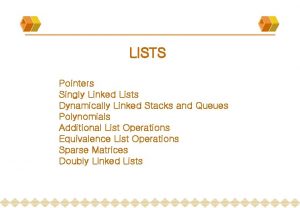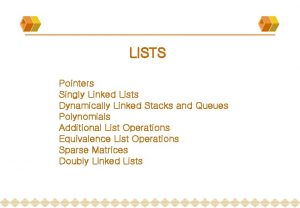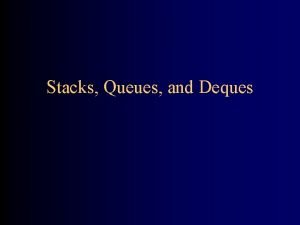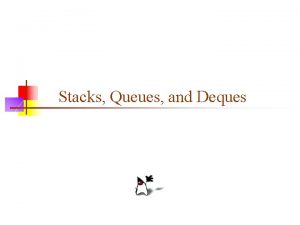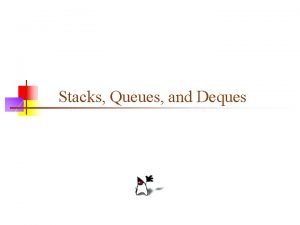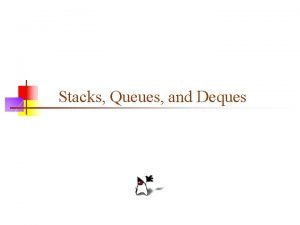Chapter 18 Linked Lists Stacks Queues and Priority





































- Slides: 37

Chapter 18 Linked Lists, Stacks, Queues, and Priority Queues 1

Objectives To design and implement linked lists (§ 18. 2). F To explore variations of linked lists (§ 18. 2). F To define and create iterators for traversing elements in a container (§ 18. 3). F To generate iterators using generators (§ 18. 4). F To design and implement stacks (§ 18. 5). F To design and implement queues (§ 18. 6). F To design and implement priority queues (§ 18. 7). F 2

What is a Data Structure? A data structure is a collection of data organized in some fashion. A data structure not only stores data, but also supports the operations for manipulating data in the structure. For example, an array is a data structure that holds a collection of data in sequential order. You can find the size of the array, store, retrieve, and modify data in the array. Array is simple and easy to use, but it has two limitations: 3

Limitations of arrays F Once an array is created, its size cannot be altered. F Array provides inadequate support for inserting, deleting, sorting, and searching operations. 4

Object-Oriented Data Structure In object-oriented thinking, a data structure is an object that stores other objects, referred to as data or elements. So some people refer a data structure as a container object or a collection object. To define a data structure is essentially to declare a class. The class for a data structure should use data fields to store data and provide methods to support operations such as insertion and deletion. To create a data structure is therefore to create an instance from the class. You can then apply the methods on the instance to manipulate the data structure such as inserting an element to the data structure or deleting an element from the data structure. 5

Four Classic Data Structures Four classic dynamic data structures to be introduced in this chapter are lists, stacks, queues, and priority queues. A list is a collection of data stored sequentially. It supports insertion and deletion anywhere in the list. A stack can be perceived as a special type of the list where insertions and deletions take place only at the one end, referred to as the top of a stack. A queue represents a waiting list, where insertions take place at the back (also referred to as the tail of) of a queue and deletions take place from the front (also referred to as the head of) of a queue. In a priority queue, elements are assigned with priorities. When accessing elements, the element with the highest priority is removed first. 6

Lists A list is a popular data structure to store data in sequential order. For example, a list of students, a list of available rooms, a list of cities, and a list of books, etc. can be stored using lists. The common operations on a list are usually the following: · Retrieve an element from this list. · Insert a new element to this list. · Delete an element from this list. · Find how many elements are in this list. · Find if an element is in this list. · Find if this list is empty. 7

Linked List Animation www. cs. armstrong. edu/liang/animation/Linked. List Animation. html 8

Nodes in Linked Lists A linked list consists of nodes. Each node contains an element, and each node is linked to its next neighbor. Thus a node can be defined as a class, as follows: class Node: def __init__(self, element): self. elmenet = element self. next = None 9

Adding Three Nodes The variable head refers to the first node in the list, and the variable tail refers to the last node in the list. If the list is empty, both are None. For example, you can create three nodes to store three strings in a list, as follows: Step 1: Declare head and tail: 10

Adding Three Nodes, cont. Step 2: Create the first node and insert it to the list: 11

Adding Three Nodes, cont. Step 3: Create the second node and insert it to the list: 12

Adding Three Nodes, cont. Step 4: Create third node and insert it to the list: 13

Traversing All Elements in the List Each node contains the element and a data field named next that points to the next element. If the node is the last in the list, its pointer data field next contains the value None. You can use this property to detect the last node. For example, you may write the following loop to traverse all the nodes in the list. current = head while current != None: print(current. element) current = current. next 14

Linked. List Test. Linked. List Run 15

Implementing add. First(e) def add. First(self, e): new. Node = Node(e) # Create a new node new. Node. next = self. __head # link the new node with the head self. __head = new. Node # head points to the new node self. __size += 1 # Increase list size if self. __tail == None: # the new node is the only node in list self. __tail = self. __head 16

Implementing add. Last(e) def add. Last(self, e): new. Node = Node(e) # Create a new node for e if self. __tail == None: self. __head = self. __tail = new. Node # The only node in list else: self. __tail. next = new. Node # Link the new with the last node self. __tail = self. __tail. next # tail now points to the last node self. __size += 1 # Increase size 17

Implementing add(index, e) def insert(self, index, e): if index == 0: self. add. First(e) # Insert first elif index >= size: self. add. Last(e) # Insert last else: # Insert in the middle current = head for i in range(1, index): current = current. next temp = current. next = Node(e) (current. next). next = temp self. __size += 1 18

Implementing remove. First() def remove. First(self): if self. __size == 0: return None else: temp = self. __head. next self. __size -= 1 if self. __head == None: self. __tail = None return temp. element 19

def remove. Last(self): if self. __size == 0: return None elif self. __size == 1: temp = self. __head = self. __tail = None self. __size = 0 return temp. element else: current = self. __head Implementing remove. Last() for i in range(self. __size - 2): current = current. next temp = self. __tail = current self. __tail. next = None self. __size -= 1 return temp. element 20

Implementing remove. At(index) def remove. At(self, index): if index < 0 or index >= self. __size: return None # Out of range elif index == 0: return self. remove. First() # Remove first elif index == self. __size - 1: return self. remove. Last() # Remove last else: previous = self. __head for i in range(1, index): previous = previous. next current = previous. next = current. next self. __size -= 1 return current. element 21

Time Complexity for list and Linked. List 22

Comparing list with Linked. List. Performance Run 23

Circular Linked Lists F A circular, singly linked list is like a singly linked list, except that the pointer of the last node points back to the first node. 24

Doubly Linked Lists F A doubly linked list contains the nodes with two pointers. One points to the next node and the other points to the previous node. These two pointers are conveniently called a forward pointer and a backward pointer. So, a doubly linked list can be traversed forward and backward. 25

Circular Doubly Linked Lists F A circular, doubly linked list is doubly linked list, except that the forward pointer of the last node points to the first node and the backward pointer of the first pointer points to the last node. 26

Iterators An iterator is an object that provides a uniformed way for traversing the elements in a container object. Recall that you can use a for loop to traverse the elements in a list, a tuple, a set, a dictionary, and a string. For example, the following code displays all the elements in set 1 that are greater than 3. set 1 = {4, 5, 1, 9} for e in set 1: if e > 3: print(e, end = ' ') 27

__iter__ Method Can you use a for loop to traverse the elements in a linked list? To enable the traversal using a for loop in a container object, the container class must implement the __iter__() method that returns an iterator as shown in lines 112 -114 in Listing 18. 2, Linked. List. py. def __iter__(self): return Linked. List. Iterator(self. __head) 28

__next__ Method An iterator class must contains the __next__() method that returns the next element in the container object as shown in lines 122 -132 in Listing 18. 2, Linked. List. py. Linked. List Test. Iterator Fibonacci. Number. Iterator Run 29

Generators are special Python functions for generating iterators. They are written like regular functions but use the yield statement to return data. To see how generators work, we rewrite Listing 18. 5 Fibnacci. Number. Iterator. py using a generator in Listing 18. 6. Fibonacci. Number. Generator Run 30

Stacks A stack can be viewed as a special type of list, where the elements are accessed, inserted, and deleted only from the end, called the top, of the stack. 31

Stack Animation www. cs. armstrong. edu/liang/animation/Stack. Anima tion. html 32

Stack Test. Stack Run 33

Queues A queue represents a waiting list. A queue can be viewed as a special type of list, where the elements are inserted into the end (tail) of the queue, and are accessed and deleted from the beginning (head) of the queue. 34

Queue Animation www. cs. armstrong. edu/liang/animation/Queue. Anim ation. html 35

Queue Test. Queue Run 36

Priority Queue A regular queue is a first-in and first-out data structure. Elements are appended to the end of the queue and are removed from the beginning of the queue. In a priority queue, elements are assigned with priorities. When accessing elements, the element with the highest priority is removed first. A priority queue has a largest-in, first-out behavior. For example, the emergency room in a hospital assigns patients with priority numbers; the patient with the highest priority is treated first. Priority. Queue Test. Priority. Queue Run 37
 Cqueue
Cqueue Java stacks and queues
Java stacks and queues Exercises on stacks and queues
Exercises on stacks and queues Java stacks and queues
Java stacks and queues 3 min quiz
3 min quiz Adaptable priority queues
Adaptable priority queues Applications of priority queues
Applications of priority queues Burman's priority list gives priority to
Burman's priority list gives priority to Priority mail vs priority mail express
Priority mail vs priority mail express Priority queue linked list python
Priority queue linked list python Singly vs doubly linked list
Singly vs doubly linked list Singly linked list vs doubly linked list
Singly linked list vs doubly linked list Perbedaan single linked list dan double linked list
Perbedaan single linked list dan double linked list Coastal landforms
Coastal landforms Representation of queues
Representation of queues Ipcs unix
Ipcs unix Message queues in rtos
Message queues in rtos Jenis struktur data
Jenis struktur data Define a queue
Define a queue Aganj
Aganj 2 stack pda
2 stack pda Coastal landforms diagram
Coastal landforms diagram Types of stacks
Types of stacks Stacks in data structures
Stacks in data structures Stacks+routined
Stacks+routined 6 stacks
6 stacks Speedstacks com go
Speedstacks com go The individual flattened stacks of membrane
The individual flattened stacks of membrane Stacks internet
Stacks internet Angle stacks
Angle stacks Chapter 22 genetics and genetically linked diseases
Chapter 22 genetics and genetically linked diseases Colon and semicolon
Colon and semicolon Lesson 3: lists practice
Lesson 3: lists practice Sound waves spelling word lists
Sound waves spelling word lists Swst spelling lists level 7
Swst spelling lists level 7 Words that end in ied
Words that end in ied Edinburgh resource lists
Edinburgh resource lists Concatinates
Concatinates
